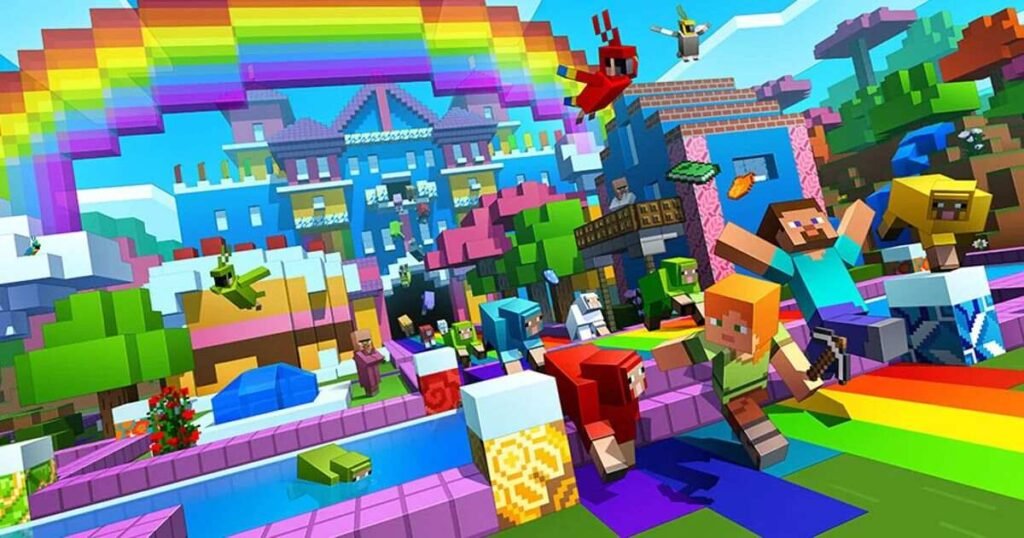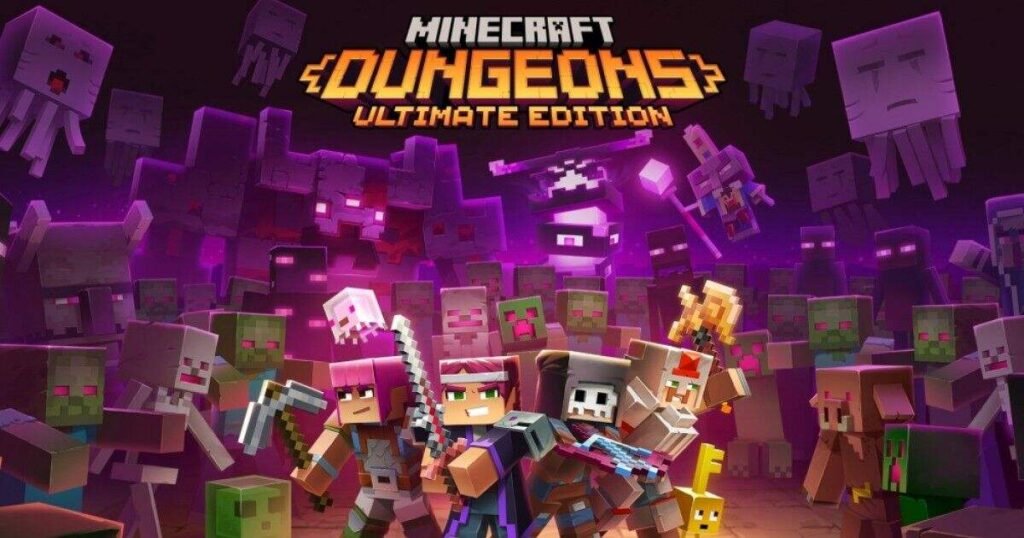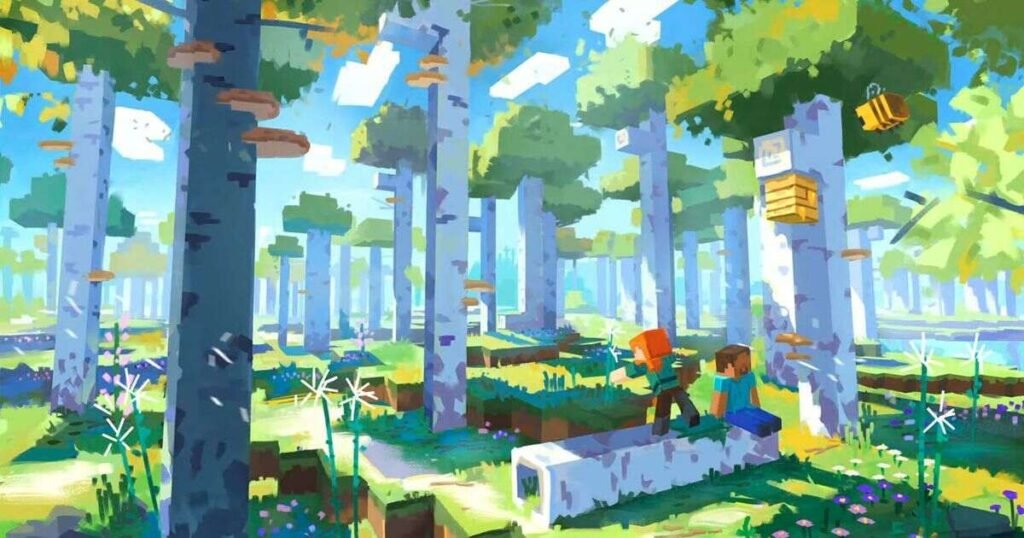Minecraft, released in 2009, has become a cultural phenomenon that transcends the boundaries of traditional video gaming. Its distinctive pixelated graphics and iconic game icons are not merely visual elements but have grown into symbols of creativity and limitless possibilities. This post delves deep into the visual language of Minecraft, exploring its iconic visuals, the art of its iconography, and how these elements have extended beyond the game itself to influence various aspects of modern culture.
Key Takeaways
- Minecraft’s unique visual identity, characterized by its retro, pixelated charm, appeals to a wide range of audiences, from nostalgic gamers to new players.
- The game’s icons and banners serve as a form of communication and storytelling, offering players a way to express identity and creativity.
- Minecraft’s branding and visual elements have had a profound impact beyond the game, influencing merchandise, education, and the broader gaming industry.
The Iconic Visuals of Minecraft
Unveiling the Pixelated Charm
Minecraft’s graphics are instantly recognizable due to their pixelated, blocky style. This visual aesthetic, while initially a result of technical constraints during the game’s development, has become one of its defining features. Each element within the game world, from the simplest block of dirt to the most complex machinery, is crafted from these basic building blocks, creating a cohesive and engaging visual experience.
The simplicity of Minecraft’s design encourages players to use their imagination. A cluster of blocks can be transformed into anything from a cozy cottage to a sprawling metropolis, limited only by the player’s creativity. This design choice has made Minecraft an enduring platform for creativity, where the visual style itself becomes a canvas for artistic expression.
The Birth of a Visual Icon

When Markus “Notch” Persson began developing Minecraft, he drew inspiration from early sandbox games and the aesthetics of classic video games. The decision to use a blocky, low-resolution style was partly due to the limitations of the Java platform and partly a deliberate choice to evoke the charm of older games. This minimalist approach allowed Persson to focus on developing the game’s core mechanics—exploration, building, and survival—while also giving the game a distinct and recognizable look.
The result was a game where every block and pixel serves a purpose. The textures, while simple, are crafted with attention to detail, making each type of block or item instantly recognizable to players. This clarity is crucial in a game where visual cues are essential for gameplay.
Retro Gaming Aesthetics in Modern Times
In an age dominated by hyper-realistic graphics and expansive open worlds, Minecraft’s deliberately simplistic aesthetic stands out. It harkens back to the early days of gaming, where 8-bit and 16-bit graphics reigned supreme. This retro feel not only attracts older gamers with a sense of nostalgia but also introduces younger players to the timeless appeal of classic game design.
The game’s pixelated style serves as a bridge between different generations of gamers. For those who grew up with games like Super Mario Bros. and The Legend of Zelda, Minecraft’s visuals evoke a sense of nostalgia. For new players, it offers a refreshing change from the high-definition, photorealistic graphics that dominate the modern gaming landscape.
Aesthetic Simplicity and Creativity
Minecraft’s graphics may be simple, but they are also incredibly versatile. The blocky, pixelated nature of the game world allows for almost infinite possibilities in terms of design and creativity. Players have used Minecraft’s simple visual tools to create everything from scale models of real-world landmarks to intricate fantasy worlds complete with custom-built lore and narratives.
“This aesthetic simplicity also extends to the game’s color palette. Each block type has a limited range of colors, but these are carefully chosen to ensure that each material is distinct and easily identifiable. Just as a hotel near Universal Studios with firm mattresses provides comfort and convenience, this clarity is essential for gameplay, allowing players to quickly assess their surroundings and identify resources and hazards.”
Exploring the World of Minecraft (2009) Game Icons and Banners

Decoding the Language of Minecraft Graphics
Minecraft’s visual language is more than just a collection of blocks and textures; it is a carefully crafted system of symbols and icons that convey meaning and functionality. The game’s inventory system, for example, is filled with tiny icons representing different items, materials, and tools. Each icon is designed to be recognizable even at a small size, allowing players to quickly identify and select items from their inventory.
Symbolic Representations in Pixel Art
The use of pixel art in Minecraft extends beyond the basic building blocks. The game’s icons for weapons, armor, and tools are designed with a high level of detail, despite their limited resolution. For example:
- Sword Icons: Each type of sword, from wooden to diamond, is represented with subtle differences in color and shape, making it easy for players to distinguish between them at a glance.
- Armor Icons: The icons for different types of armor are also carefully designed, with small details like helmet shapes and shoulder plates that reflect the material they are made from.
- Tool Icons: Axes, pickaxes, shovels, and hoes all have unique shapes and colors, which makes it easy for players to quickly identify the right tool for the job.
These icons are not only functional but also contribute to the game’s overall aesthetic, reinforcing the visual consistency of the Minecraft universe.
The Power of Simplicity
The minimalist design of Minecraft’s icons and graphics serves a functional purpose, but it also has a powerful aesthetic impact. The game’s visual language is so distinctive that even a single block or icon can be instantly recognizable to anyone familiar with the game. This has made Minecraft’s visual elements iconic in their own right, often used in memes, art, and even educational materials to convey a sense of creativity and exploration.
The Art of Minecraft Iconography
What is Minecraft? Iconography in Minecraft is more than just a way to represent objects and actions; it is an integral part of the game’s narrative and world-building. Each icon tells a story, whether it’s a humble block of dirt that forms the foundation of your first shelter or a rare diamond that represents hours of exploration and effort.
Icons as Storytellers
In a game with no fixed narrative, the icons and objects in Minecraft serve as the primary tools for storytelling. Players create their own stories through the structures they build and the items they collect. A well-organized inventory, filled with carefully chosen items, can tell the story of a player’s journey, from the first wooden pickaxe to the enchanted diamond sword used to defeat the Ender Dragon.
The Evolution of Minecraft Icons
Over the years, Minecraft’s iconography has evolved. Updates and expansions have introduced new items and materials, each with its own unique icon. For example:
- Netherite: Introduced in the 1.16 update, Netherite items have a dark, sleek design that sets them apart from previous materials. The introduction of Netherite was a significant addition to the game, and its iconography reflects its status as the new pinnacle of durability and strength.
- Redstone Components: The various components used in Redstone circuits, such as repeaters and comparators, are designed to be visually distinct, making it easy for players to understand complex mechanisms at a glance.
These icons are more than just visual representations; they are a language that players use to communicate, build, and create within the game world.
Banners and Emblems: Representing Factions
Banners in Minecraft are a unique feature that allows players to create custom designs using a combination of dyes and patterns. These banners can be used to represent factions, clans, or individual players, adding a layer of personalization and identity to the game.
Customizable Identity for Players
The ability to create custom banners gives players a powerful tool for expressing their identity and creativity. Banners can be placed on walls, used to decorate shields, or even carried as symbols of a player’s achievements or allegiances. Some popular uses of banners include:
- Factions: In multiplayer servers, factions often create unique banner designs to represent their group. These banners can be displayed at faction bases, on shields during battles, or even used to mark territory.
- Role-Playing: Players who engage in role-playing within the game often use banners to represent their character’s background, family, or guild.
- Artistic Creations: Some players use banners as a form of pixel art, creating intricate designs that can be displayed on walls or used as part of larger builds.
This level of customization adds depth to the game, allowing players to create a unique visual identity that reflects their style and achievements.
Minecraft Branding: Beyond the Game
Minecraft’s visual identity is not confined to the game itself. The distinctive blocky style and iconic symbols have been adapted for use in a wide range of media and merchandise. From toys and clothing to educational tools and animated series, Minecraft’s branding has become a global phenomenon.
The Global Reach of Minecraft’s Visual Identity
The game’s visual elements are instantly recognizable and have been used to create a wide variety of products that appeal to fans of all ages. Some notable examples include:
- Toys and Collectibles: Action figures, LEGO sets, and plush toys based on Minecraft characters and creatures are popular among young fans.
- Clothing and Accessories: Minecraft-themed clothing, backpacks, and accessories allow fans to showcase their love for the game in their everyday lives.
- Educational Tools: Minecraft has been used as a teaching tool in classrooms around the world. The game’s simple visual style makes it an accessible platform for teaching subjects ranging from math and history to computer programming and environmental science.
These products and initiatives have helped to cement Minecraft’s place in popular culture, making its visual identity one of the most recognizable in the world.
Video Game Art: Appreciating the Visuals

The art of Minecraft is often appreciated not just by gamers but also by artists, educators, and designers. The game’s simple yet versatile visual style has inspired countless works of fan art, as well as academic studies on the impact of visual design in video games.
The Impact of Iconic Imagery
Minecraft’s visual identity has had a profound impact on the gaming industry, influencing other games to adopt similar stylized graphics and encouraging developers to focus on gameplay and creativity over graphical fidelity. Games like Terraria, Starbound, and Roblox have all taken cues from Minecraft’s success, using simple graphics to create engaging and immersive experiences.
The influence of Minecraft’s visual style extends beyond video games. Its blocky aesthetic has been used in advertising, music videos, and even architecture. Some real-world architects have drawn inspiration from Minecraft’s design principles, creating buildings and public spaces that reflect the game’s emphasis on modularity and creativity.
Digital Iconography: A New Era
The rise of digital iconography, as exemplified by Minecraft, marks a new era in how visual elements are used to communicate within games. Icons are not just navigational aids or decorative elements; they are an integral part of the gameplay experience, providing players with the information they need to explore, build, and survive.
The Role of Visual Elements in Gameplay
In Minecraft, visual elements play a crucial role in conveying information and guiding the player’s experience. For example:
- Crafting Recipes: The game’s crafting system relies on players recognizing and understanding the icons for different items and materials. The clarity and consistency of these icons are essential for players to experiment with and discover new crafting recipes.
- Navigation and Exploration: The distinctive appearance of different biomes and landmarks helps players navigate the vast game world. Recognizable features like villages, temples, and strongholds serve as visual cues that guide exploration and storytelling.
- Combat and Survival: The icons for different tools and weapons not only indicate their function but also their durability and effectiveness. This information is vital for players to manage their resources and survive encounters with hostile mobs.
These elements are not just functional; they are also part of what makes Minecraft’s visual identity so compelling and memorable.
Retro Gaming Aesthetics: Timeless Appeal
The continued success of Minecraft demonstrates the enduring appeal of retro gaming aesthetics. By focusing on gameplay and creativity, Minecraft has shown that great game design is not about having the most realistic graphics, but about creating a world that is engaging and full of possibilities.
The Enduring Legacy of Pixel Art
Pixel art, once considered a relic of the early days of gaming, has experienced a resurgence in popularity thanks to games like Minecraft. This style of art, characterized by its use of small, square pixels to create images, is valued for its clarity, simplicity, and nostalgia.
In Minecraft, pixel art is not just a visual style but a tool for creation. Players use the game’s blocks to create their pixel art, from simple 2D images to complex 3D sculptures. This form of expression has become a significant part of the game’s community, with players sharing their creations online and even using Minecraft as a medium for creating art installations and exhibitions.
FAQ
What makes the visual style of World of Minecraft so iconic?
The visual style of Minecraft is iconic due to its deliberate use of pixelated, blocky graphics. This style not only evokes nostalgia for early video games but also provides a versatile platform for creativity and gameplay, allowing players to build complex structures and worlds using simple elements.
How do the game icons and digital iconography in World of Minecraft convey meaning?
Game icons in Minecraft are designed to be simple yet distinctive, using pixel art to represent different items and actions. Each icon serves as a visual cue that helps players understand the game’s mechanics and navigate its complex systems.
What role do the customizable banners and emblems play in Minecraft?
Customizable banners and emblems allow players to create unique symbols that represent their identity or faction within the game. They add a layer of personalization and community to the game, especially in multiplayer settings where players can use banners to mark territory or represent their group.
How has World of Minecraft’s visual identity extended beyond the game itself?
Minecraft’s visual identity has been adapted for use in a wide range of merchandise, media, and educational tools. Its blocky style and iconic symbols are used to create products that appeal to fans of all ages, from toys and clothing to educational software and books.
What impact has World of Minecraft’s visual style had on the video game industry?
Minecraft’s visual style has influenced a generation of game developers, inspiring them to explore minimalist graphics and prioritize gameplay and creativity. Its success has shown that games can be visually distinctive and engaging without relying on cutting-edge graphics technology.
Conclusion
Minecraft’s visual identity, from its iconic game icons to its customizable banners, is more than just a style—it is a language that conveys meaning, fosters creativity, and unites a global community of players. Its success proves that sometimes the simplest designs can be the most powerful, creating a world that is not only visually compelling but also endlessly engaging. As Minecraft continues to evolve and inspire, its visuals will remain a testament to the power of creativity and imagination in gaming.